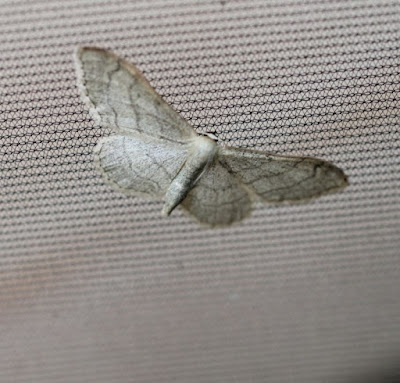 |
| Single-dotted Wave (Ideae dimidiata) |
Yesterday morning, while looking at the photographs from Thursday night's trap, we came to the conclusion that a new species had arrived at Shandy Hall - the Single-dotted Wave (Idaea dimidiata). We had difficulty locating it in Humphreys & Westwood (their illustrated picture is included beneath) because its taxonomy has changed with the years - it is recorded as Ptychopoda lividata in their 1845 edition. The moth was not easy to identify; that can in part be attributed to its proclivity to show up in varying colors - from bleached cream to tawny brown; ours was of the former. At first we suspected it might be a pug (satyr or ochreous, even though the colorings did not match up), because of the precise resting position and shape of its wings - in our photograph it appears narrower than in the Field Guide. However, the discrepancies in colors and lack of exact pattern matchings made identification inconclusive; only after consulting with Dave Chesmore from the University of York were we able to label it a new species. The Single-spotted Wave is common throughout Britain, found mainly in damp locations. I have concluded that the easiest way to recognize it is through the matching large dark dots on the edges of its wings; and how its "lines" appear to be comprised of small, speckled dots, as opposed to clearly delineated colorings.
Post by Ariel Smith
 |
| Single-dotted Wave (illustration) |
Having completed our investigations it was then noticed that there was an image of the Single-dotted Wave as a miscellaneous moth on the sidebar of the blog - dated 2011. It wasn't a new species after all but had been captured and identified before the blog records were kept.
 |
| Riband Wave (Idaea aversata) |
Trying to identify the pretty moth above, the colouring seemed to indicate that it must be a Smoky Wave - but it turns out to be a Riband Wave though greyer than usual. Checking through old photographs of the Riband Wave posted on our blog, we found a second error in our archive - the moth beneath...
 |
Small Blood-vein (Scopula imitaria)
|
...had been mistakenly identified as a Riband but should have qualified as a new species - the Small Blood-vein. So the new total of 364 moth species is correct, but not as we thought.
The Small Blood-vein (Scopula imitaria) is not a common moth in North Yorkshire so we should have paid greater attention to its arrival in Coxwold. The scientific name refers to a scopula (a small broom) and imitaria (to imitate or counterfeit). Your guess is as good as mine.
 |
| Small Blood-vein (illustration) |





